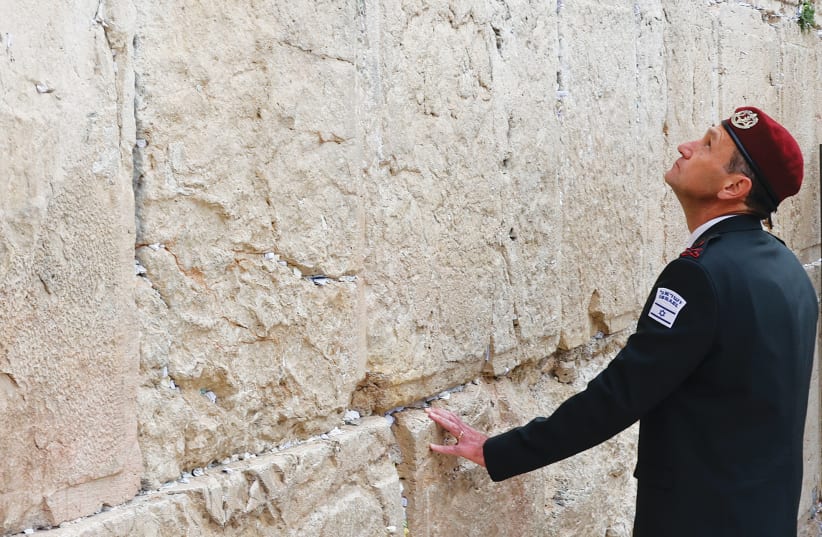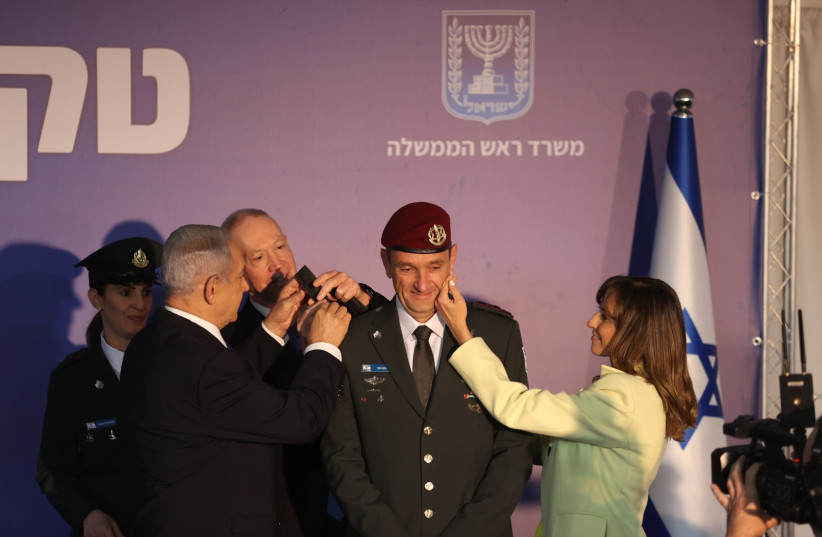“The harder the conflict, the greater the triumph,” said George Washington in what should inspire the IDF’s new commander, Lt.-Gen. Herzi Halevi.
“The harder the conflict, the greater the triumph.”
George Washington
Like all his 22 predecessors, the 55-year-old paratrooper’s tasks include varied military challenges in multiple arenas. However, on top of handling those, Halevi will also be tasked with retaining the Israeli military’s role as a polarized society’s most effective glue.
Halevi’s military challenges straddle five fronts: the twin Palestinian arenas in Gaza and the West Bank, and the three Iranian-inspired arenas in Syria, Lebanon and Iran itself. Each of the five is different from the rest.
Gaza is detached from Israel and its threat is mostly about organized, artillerist terrorism; the West Bank is intertwined with Israel and its threat is about unorganized, grassroots terrorism and guerrilla attacks; the Lebanese front, like Gaza, is about organized guerrilla attacks and terrorism, but it comes from within a sovereign state; Syria is about the IDF’s own guerrilla attacks on Iran’s military buildup there; and lastly, Iran itself, poses the threat of total war.
Halevi’s task in the first four arenas is clear: Pick up from where his predecessor left off. That cannot be said of a war with Iran.
Israel-Iran War will be more like Russia-Ukraine than like Israel-Gaza
HALEVI BRINGS extensive experience in fighting guerrillas and terrorists in varied positions in Lebanon, Gaza and the West Bank. However, having been a 10th-grader when the IDF last clashed with enemy tanks and warplanes, he never participated in a conventional war.
Halevi is not unique in this. Very few military commanders anywhere today experienced old-style wars, which since the 1980s’ Iran-Iraq War seemed to have become prehistoric. The war in Ukraine changed this impression.
While that war’s particular form is novel – fewer warplanes and tanks, more missiles, drones and artillery – it is a conventional war nonetheless, pitting two industrialized states along with their vast human, material and political resources.
A prospective Iranian-Israeli war will be a variation of this theme, with the added uniqueness that its rivals will be 1,000 km. apart. This means that Halevi must prepare the IDF for what it did not experience in 40 years: conventional war, an Armageddon that would potentially involve everything and everyone, from infantry, artillery and armor to warplanes, gunships, submarines and frogmen.
Worse, a clash with Iran might quickly proceed from conventional war to total war, an attack of the sort Russia is waging in Ukraine, systematically targeting power stations, water supply, roads, bridges and apartment blocks.
This means that alongside preparation for a conventional offensive – involving large-scale maneuvering of tens of thousands of troops and their vehicles – there must be accompanied planning for a huge defensive effort to shield Israel’s 80 cities, treat massive civilian casualties and shelter thousands of refugees.
Yes, it’s a daunting task, one that will hopefully never come to a test. Even so, what awaits Halevi on his job’s social side is no less fateful, and in some ways even more daunting, because unlike war with Iran, which has yet to erupt, the war for Israel’s social cohesion is already underway.
Making the IDF the people's army again
IN ITS 75 years of existence, the IDF has taken on some ambitious social goals. In the 1950s, the IDF sent soldiers to teach Hebrew to new immigrants and thus played an important role in absorbing the early immigration waves.
Similarly, this century the IDF created a special program that converted more than 10,000 non-Jewish soldiers and thus helped absorb the post-Soviet immigration.
Beyond such efforts, the IDF made Israelis of all backgrounds get to know each other, forging lifelong relationships that defy class, tribe and faith. Now, this priceless melting pot is cracking.
The share of non-enlisting men aged 18-20 has doubled over the past 30 years, from 16.6% to 30% of an annual intake of conscripts, according to the Institute for National Security Studies.
Among women, 40% don’t enlist. Among men, half of the non-enlisting are ultra-Orthodox, while 12% of new conscripts are exempted due to psychological reasons, nearly three times their share as recently as 2014. These are presumably mostly secular. When adding the Israeli Arabs who do not enlist, the IDF is left with hardly one in two high school graduates joining its ranks.
In other words, Halevi’s IDF is ceasing to be the “people’s army” in which the elder Herzl Halevi – the uncle after whom he is named – served when he was killed in the Six Day War’s battle for Jerusalem.
While the IDF’s social depletion has been creeping from below for years, it now is being encouraged also from above, as far-right ministers set out to detach the West Bank’s civil administration and Border Police units from the IDF’s command, and thus potentially break the IDF into sectarian-inspired militias.
This is the exact opposite of David Ben-Gurion’s vision when he dismantled the left-leaning Palmah and the right-leaning Irgun and Lehi in order to create a reunited Jewish people’s one army. Halevi’s social task is therefore to make military service a source of pride for the serving and envy for the non-serving, and at the same time fend off the army’s political poachers.
This is, of course, besides his daily diet of skirmishing in the West Bank and preparing for new bouts with Hamas, war with Hezbollah, and Armageddon with Iran.
The “great triumph” of which Washington spoke is distant, but the “harder conflict” is here, laying siege to Herzi Halevi from his Palestinian flanks, Lebanese rear and Iranian front, as well as the social floor under his feet and the political ceiling above his head.
As we wish you success, Lt.-Gen. Halevi, our only words of consolation are that the multi-tiered, “harder conflict” you now face – is probably as hard as it gets.
www.MiddleIsrael.net
The writer, a Hartman Institute fellow, is the author of the bestselling Mitzad Ha’ivelet Ha’yehudi (The Jewish March of Folly, Yediot Sefarim, 2019), a revisionist history of the Jewish people’s political leadership.

